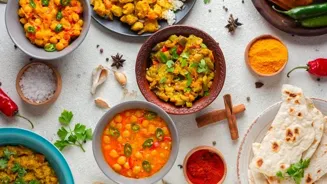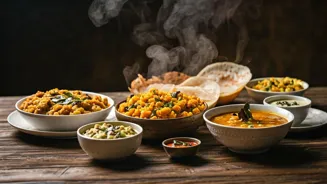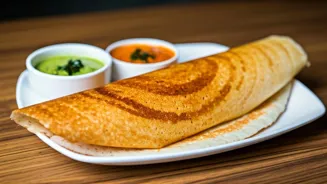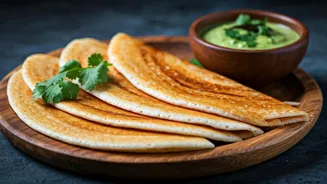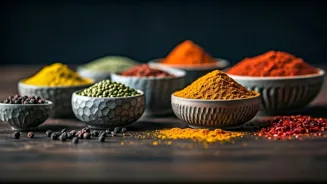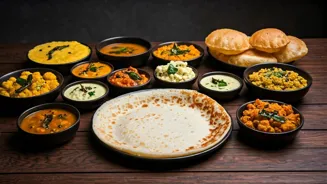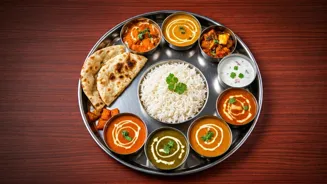Unlock the Secrets of a Balanced Indian Meal: Nutrition and Flavor Tips. Dive into a world of wholesome cuisine!
Namaste, readers! Ever wondered how our grandmothers managed to create such wholesome and delicious
meals, packed with goodness and taste? The secret, my friends, lies in the art of balancing.
A balanced Indian meal isn't just about filling your stomach; it's about nourishing your body with the right proportions of nutrients while tantalizing your taste buds.
Let's dive into the colourful world of Indian cuisine and unlock the secrets to creating truly balanced and fulfilling vegetarian meals.
Foundation of Indian meal: balance carbs, proteins, fats, vitamins, minerals
The foundation of any good Indian meal is a mix of carbohydrates, proteins, fats, vitamins, and minerals. Think of it like building a house – you need a strong base and equally important supporting structures.
Carbohydrates provide the energy we need to go about our day, and they usually come from grains like rice, roti (wheat flatbread), or millets like ragi and jowar.
Proteins are crucial for building and repairing tissues; lentils (dal), chickpeas (chana), and paneer (Indian cheese) are excellent sources, especially for vegetarians. Don't be afraid of fats!
Healthy fats, found in ghee (clarified butter), vegetable oils, and nuts, are essential for hormone production and nutrient absorption.
And finally, let's not forget the vibrant world of vegetables and fruits, which contribute vital vitamins, minerals, and fibre, acting as the protective layer for our overall wellbeing.
Main components of a balanced meal for energy and nutrients
Now, let’s talk about the main components. Roti, rice, or any other grain is often the star of the show, providing the bulk of your energy. But remember, variety is key! Try switching between different grains to get a broader spectrum of nutrients.
Whole wheat roti is a great source of fibre, while brown rice offers more nutrients compared to white rice. Lentils (dals), are your protein champions. Experiment with different types like toor dal, moong dal, masoor dal, and urad dal.
Ensure you have different types of vegetables to compliment your meal. They shouldn’t just be a side to your grain and dal. Incorporate a rainbow of colours!
Green leafy vegetables like spinach and mustard greens are packed with vitamins, while colourful vegetables like carrots, bell peppers, and beetroot offer a range of antioxidants. A small serving of healthy fat like ghee or a spoonful of nuts or seeds completes the dish.
This not only enhances flavour but also helps your body absorb fat-soluble vitamins.
Balancing flavors in Indian cuisine for a delightful meal
Let's also consider the art of balancing flavours. Indian cuisine is famous for its complex and layered flavors – sweet, sour, salty, bitter, and pungent – but it's important to strike a balance. Overpowering flavors can make the meal less enjoyable and even lead to digestive issues.
Think about contrasting elements. If you're having a rich and creamy dal makhani, balance it with a lighter vegetable dish like a simple stir-fried bhindi (okra) or a refreshing raita (yogurt dip).
If you are using spicy flavors in your sambhar, balance it with a dash of sweetness from jaggery or a sweet vegetable stir-fry. Be mindful of your use of salt and spices. Too much salt can lead to water retention and other health issues. Similarly, excessive spices can irritate the stomach.
Use fresh herbs like coriander, mint, and curry leaves to add flavour without resorting to excessive spices.
Approach to balanced vegetarian Indian meals: variety is key
Next, let’s discuss how to approach vegetarian Indian meals. It’s easy to create a balanced vegetarian Thali at home. Start with a base of roti or rice. Add two or three different types of vegetables – a dry vegetable, a gravy-based vegetable, and a green leafy vegetable.
Include a dal or sambhar for protein. Add a side of yogurt or raita for probiotics and calcium. And don't forget a small serving of pickle or chutney to add flavour and aid digestion. Remember the key is variety! Don't just stick to the same old potato and tomato sabzi every day.
Explore different vegetables and cooking methods to keep your meals interesting and nutritious.
Eat seasonally for fresher, nutrient-rich meals
Here's a simple trick to use while creating healthy meals. Aim to eat according to the season. Seasonal produce is not only fresher and tastier, but also packed with nutrients that are specifically beneficial for that time of year.
In summers, enjoy cooling vegetables and fruits like cucumbers, watermelons, and gourds. In winters, opt for warming foods like root vegetables, spinach, and mustard greens. Drink plenty of water throughout the day, especially with your meals.
Water aids digestion and helps your body absorb nutrients more effectively. A glass of lassi (buttermilk) or chaas (spiced yogurt drink) is also a great addition to your meals, especially during summers.
Creating a balanced Indian meal is about nutrition, variety, flavor, and enjoyment
In conclusion, creating a balanced Indian meal is not rocket science; it's all about understanding the basic principles of nutrition and applying them to our delicious and diverse cuisine. Focus on incorporating a variety of grains, lentils, vegetables, and healthy fats.
Pay attention to flavour combinations and season your food mindfully. And most importantly, enjoy your meals! Eating should be a pleasurable experience, not a chore.
By following these simple tips, you can create meals that are not only nutritious and delicious but also deeply satisfying and nourishing. So, go ahead, experiment with different ingredients and recipes, and discover the joy of creating truly balanced and flavourful Indian meals.
Happy cooking and happy eating.
AI Generated Content. Glance/InMobi shall have no liability for the content